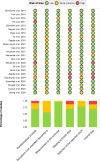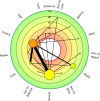Evaluating exercise therapies in adolescent idiopathic scoliosis: a systematic review with Bayesian network meta-analysis
- PMID: 40183057
- PMCID: PMC11967429
- DOI: 10.7717/peerj.19175
Evaluating exercise therapies in adolescent idiopathic scoliosis: a systematic review with Bayesian network meta-analysis
Abstract
Background: Exercise therapy represents a financially prudent and readily applicable intervention that has gained considerable traction in the treatment of adolescent idiopathic scoliosis (AIS) in recent years. Nevertheless, a definitive agreement on the superiority of one method over another remains elusive.
Methods: A comprehensive search was performed across the PubMed, Cochrane Library, Embase, and Web of Science databases for randomized controlled trials pertaining to exercise and AIS, concluding on August 20, 2024. Four independent researchers conducted a thorough review of the literature, engaged in meticulous data extraction, and assessed the risk of bias. A Bayesian network meta-analysis was performed utilizing the R programming language (version 4.3.4) and MetaInsight tool (version V6.0.1).
Results: A total of 23 studies were incorporated into the analysis, encompassing 1,289 participants with AIS. Compared to the control group, the primary meta-analysis showed that both SchrothCo and physiotherapeutic scoliosis-specific exercises (PSSE) modalities significantly improved Cobb angle (MD = -4.79, 95% CI [-8.56 to -1.11] MD = -3.11, 95% CI [-5.27 to -0.9]), axial trunk rotation (ATR) (MD = -3.03, 95% CI [-4.68 to -1.46]; MD = -2.37, 95% CI [-3.59 to -1.14]), and SRS-22 scores (MD = 0.66, 95% CI [0.39-0.94]; MD = 0.44, 95% CI [0.22-0.66]). The secondary meta-analysis showed that within the PSSE modality, Schroth therapy significantly reduced Cobb angle (MD = -2.3, 95% CI [-5.45 to -0.66]), while in the SchrothCo modality, both Schroth + Core and Schroth + Hippotherapy significantly improved Cobb angle (MD = -5.27, 95% CI [-14.15 to -3.5]). For ATR, Schroth therapy within PSSE (MD = -2.79, 95% CI [-6.4 to -0.1]), and Schroth + Core (MD = -4.03, 95% CI [-9.37 to -0.98]), Schroth + Sling (MD = -3.12, 95% CI [-10.05 to -2.94]), and Schroth + Hippotherapy (MD = -3.39, 95% CI [-10.29 to -2.84]) within the SchrothCo modality all showed significant reductions. Significant differences in SRS-22 scores were found only in the PSSE modality with Schroth therapy (MD = 0.48, 95% CI [0.02-0.9]) and in the SchrothCo modality with Schroth + Core (MD = 0.79, 95% CI [0.13-1.43]).
Conclusions: According to the latest findings, the integration of the Schroth method with core stabilization training (Schroth + Core) is regarded as the optimal strategy for addressing AIS. The integration of core stabilization training with the Schroth method reveals a markedly enhanced effectiveness. Future inquiries should encompass more rigorous studies to establish a more robust evidence foundation and facilitate progress in this domain.
Keywords: AIS; Adolescent Idiopathic Scoliosis; Exercise; Exercise therapies; Network meta-analysis; Scoliosis.
©2025 Jiang et al.
Conflict of interest statement
The authors declare there are no competing interests.
Figures






References
-
- Abdel-aziem AA, Abdelraouf OR, Ghally SA, Dahlawi HA, Radwan RE. A 10-week program of combined hippotherapy and scroth’s exercises improves balance and postural asymmetries in adolescence idiopathic scoliosis: a randomized controlled study. Children. 2021;9:23. doi: 10.3390/children9010023. - DOI - PMC - PubMed
-
- Baumann AN, Orellana K, Oleson CJ, Curtis DP, Cahill P, Flynn J, Baldwin KD. The impact of patient scoliosis-specific exercises for adolescent idiopathic scoliosis: a systematic review and meta-analysis of randomized controlled trials with subgroup analysis using observational studies. Spine Deformity. 2024a;12:545–559. doi: 10.1007/s43390-023-00810-x. - DOI - PubMed
Publication types
MeSH terms
LinkOut - more resources
Full Text Sources
Medical
Miscellaneous

